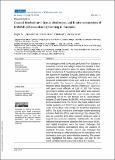| dc.description.abstract | An investigative field survey was performed from October to
November 2023 at nine villages within five districts in four
selected regions, aimed to assess the status, challenges, and
future perspectives of coastal mariculture development along
the coastline in Mainland Tanzania. During this study, both
purposive and snowball sampling techniques were used. A
structured questionnaire forms were used as an assessment
tool to gather fish farmers’s information, followed by a
focussed group discussion and key informants’ interviews
with government officials. A total of 162 fish farmers,
government officials and animal feed sellers were assessed.
Demographic data indicated that most farmers were male
accounting for 67.9% and females (32.5), aged between
between 20 and 40 years old (56.8%), with primary education
level, accounted for 82.7%. On the other hand, milkfish were
mostly stocked at 2-3 fish/m2 in an earthen pond system, and
under monoculture were mostly fed local feed ingredients
(88%). The study showed that three major income-generating
activities: Milkfish (85%), crab fattening (12%), tilapia (2%), and sea cucumber (1%) were practiced along the coast to
support blue economy initiatives. Additionally, the results
indicated that government subsidies (89), farm inputs (81%),
and capital investment were the major challenges that
constrained milkfish development along the coastline of
mainland Tanzania. Further, current data indicated that
milkfish farming is solely practiced at the subsistence level
and needs a scale-up to sustain the blue economy. The present
study highlighted the status, challenges, and plan for the
future development of coastal mariculture in Tanzania. | en_US |

